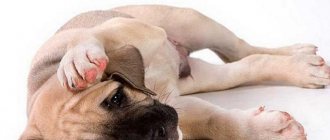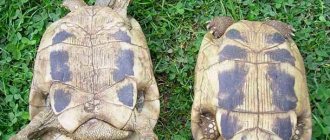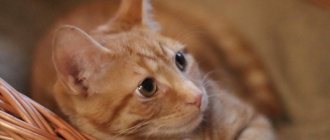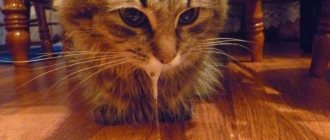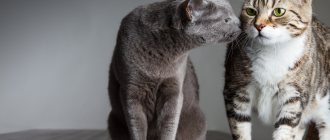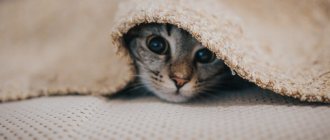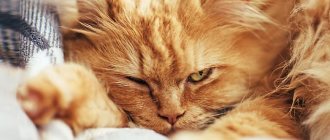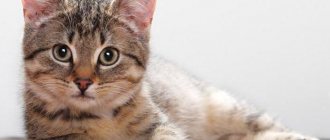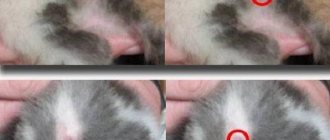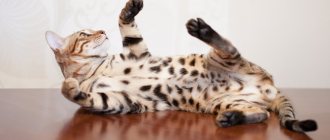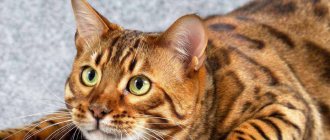Urinalysis (urine) is one of the main laboratory tests used to identify deviations in baseline indicators. Based on its results, the veterinarian determines the animal’s health status, prescribes additional tests and adjusts the treatment regimen.
In most cases, the result of the study comes the next day after the biomaterial is submitted. If a return visit to the doctor is planned for a later time, then you can try to decipher the indicators yourself.
When is it necessary to take a urine test?
First of all, donating material is necessary if you suspect diseases of the urinary system. The composition of urine evaluates the functionality of internal organs and identifies inflammation. The study is also necessary to monitor the effectiveness of treatment and prevent complications.
The owner should be wary of frequent visits to the litter box, pain when urinating, changes in the color and smell of stool. The most dangerous condition is the complete absence of urination during the day. Left without help, the pet risks dying from a ruptured bladder.
If at least one of the listed symptoms is detected, it is recommended to collect samples of discharge as soon as possible and contact a veterinary clinic.
Features in children
Urine in newborn babies is almost colorless, while in infants it is light yellow. The discovery of green urine in a child should alert parents, as this may be a signal of health problems.
The appearance of brownish-green urine in a baby may be associated with obstructive jaundice. The main symptoms of the disease include:
- severe itching;
- sudden weight loss;
- staining of the mucous membranes and skin in a jaundiced-pale color;
- colorless stool;
- increased bile content;
- Body temperature
Physical indicators
Physical indicators are studied using organoleptics - a research method based on the perception of the senses: visual, olfactory and tactile. The only exception is pH, or acidity. It is calculated based on the specific gravity of urine.
Volume allocated per day
Norm
: 7-15 ml per 1 kg of weight.
Promotion
: may mean chronic renal failure, metabolic disorders, kidney infections, diabetes, inflammation, the presence of neoplasms, hypercalcemia, disappearance of edema.
Demotion
: may mean acute renal failure, increased edema, shock, gastrointestinal disorders (diarrhea, nausea), insufficient water intake.
The volume released per day directly depends on the liquid drunk per day. It accounts for 70% of urine. The exact amount is determined in the hospital, since at home the filler poured into the tray gets in the way.
Color
Norm
: yellow and light yellow.
Darkening of the shade is typical for diarrhea, vomiting, burns, liver diseases, poisoning, urolithiasis, hemolytic anemia, melanosarcoma, hemoglobinuria, pyelonephritis, urocystitis, glomerulonephritis.
Lightening of the shade is typical for diabetes mellitus, impaired concentration function of the kidneys, prolonged use of medications and some vegetables (beets, carrots).
Chromaticity is denoted as COL. It directly depends on the type of feeding and daily water consumption. The more a cat drinks, the lighter its urine.
Brief discoloration due to certain foods and medications is acceptable. Pathology is discussed only when the deviation persists for more than 2 days. Depending on the disease, the yellow tint changes to scarlet, green, beer and completely black.
Consistency
Norm
: liquid.
Thickening to a mushy and jelly-like form indicates purulent processes and urolithiasis. Also, inclusions of mucus are characteristic of cystitis and inflammatory processes in the urinary tract.
To determine this parameter, temporarily remove the litter and wait until the pet goes to the toilet. Slowly pour the biomaterial from the tray into any container. If the animal is healthy, then the consistency of its liquid feces should resemble ordinary water.
Clarity and sediment
Norm
: complete transparency with a small sediment of epithelium, microorganisms, salts, crystals.
Severe clouding occurs with urolithiasis, malignant neoplasms, prostatitis, inflammation of the kidney tissue, bladder and ureters.
Transparency is designated as CLA. If you take a glass of urine from a healthy animal, you can easily read the printed text through it. The exact cause of the clouding will be determined with the help of additional tests. Sometimes the deviation is due to improper transportation.
Smell
Norm
: specific, unsharp.
Changes in odor are rare. A strong stench occurs during prolonged stagnation, characteristic of blockage of the urinary tract. If the smell resembles rot or feces, then the cause of the changes lies in cystitis or paraproctitis (rectal fistula).
Specific gravity (density)
Norm
: 1.015-1.030 (has no units of measurement, as it is a relative value).
Promotion
: may mean dehydration, increased edema (acute glomerulonephritis), toxicosis, acute nephritis.
Demotion
: may mean diabetes insipidus, heavy drinking, chronic renal failure and acute tubular damage, infusion therapy, nephrosclerosis.
Specific gravity is denoted as USG. It evaluates the work of the kidneys by dissolving solid compounds in urine, that is, its concentration. The density changes several times a day, so it is recommended to check several samples at once. An increased concentration is typical for the morning collection of biomaterial after a long sleep.
Acid reaction
Norm
: 6.0-7.0 mol/l.
Promotion
: may mean hypokalemia, metabolic disorders (alkalosis), bacterial infection, chronic renal failure, oncology of the genitourinary system.
Demotion
: May indicate renal failure, diabetic coma, nephritis.
Acidity is referred to as pH. In addition to the disease, the type of diet affects the deviations. An excess of animal proteins leads to oxidation and lowers acidity, and an excess of plant foods leads to alkalization and an increase in pH. Long-term deviation is fraught with the appearance of urates - urinary stones that cause urolithiasis.
Additional symptoms that indicate illness
Green urine is one of the manifestations of infectious inflammation in the genitourinary system. Typically, inflammation is accompanied by frequent urge to go to the toilet, pain and stinging during the process of emptying the bladder. The acute course of the pathology is accompanied by pain in the lower back and lower abdomen, and an increase in body temperature.
If you have liver and gallstone problems, in addition to green urine, you are also worried about pain in the abdominal cavity, increased gas formation and the urge to vomit. In the most advanced cases, chills and increased body temperature, pain in the right hypochondrium, bitter taste in the mouth, and skin rashes are observed.
With gonorrhea, green urine is observed in both women and men. This is accompanied by pain and burning during urination, and the discharge of drops of pus from the urethra in the morning.
In men with prostatitis, in addition to producing green urine, there are difficulties with emptying the bladder, fluid retention occurs, and groin and lower back pain.
With prolonged prostatitis, the infection can rise higher and affect the kidneys. This is fraught with serious complications, including disruption of the filtration organs.
Chemical indicators
In a biochemical study, the presence and quantity of substances are determined using special devices - analyzers. Some indicators are not present in a healthy body, so their appearance is taken as a deviation.
Bilirubin and urobilinogen
Norm
: none.
Promotion
: may mean blood and liver pathologies, blockage of the bile ducts, jaundice.
Demotion
: –
Bilirubin (BIL) is a bile pigment, and urobilinogen is a product of its reduction, formed by intestinal bacteria. Oxidized urobilinogen is converted into urobilin, which changes the color of urine to a darker one. The appearance of at least one of these indicators indicates the presence of pathology.
Protein and urea
Norm
: protein – less than 0.3 g/l; urea – 5.4-12.1 g/l.
Promotion
: may mean renal failure, feeding high protein foods, acute hemolytic anemia, urolithiasis, urinary tract infections.
Demotion
: may mean a lack of protein in the diet, kidney and liver pathologies.
Protein (PRO) is a product of cell breakdown, indicating destructive inflammatory processes and disturbances in the functioning of internal organs. As a result of its breakdown, urea (URO) is formed. In a healthy pet, only fragments of this compound are observed. Temporary fluctuations are acceptable after stress, hypothermia, in the last days of pregnancy and the first three days in newborns.
Glucose
Norm
: absent
Promotion
: may mean pancreatic dysfunction, excessive production of thyroid hormones; diabetes mellitus, impaired nephron functionality.
Demotion
: –
A physiological increase in glucose levels (GLU) is associated with emotional stress and prolonged use of certain medications (glycosides, steroids, adrenaline). If excess carbohydrates do not have a pathological cause, then treatment is not required.
Ketone bodies
Norm
: none
Promotion
: may mean comatose and precomatous state, excess fat in the diet, fever, postoperative period, prolonged fasting, hypoglycemia, acute pancreatitis, diabetes mellitus, poisoning, hypercortisolism syndrome.
Demotion
: –
Ketone bodies (KET) are the brain's main source of energy when food is insufficient. Their appearance in urine is called ketonuria. This condition is accompanied by a characteristic odor of acetone.
Nitrites
Norm
: none
Promotion
: May indicate a urinary tract infection.
Demotion
: –
Nitrites (NIT) appear in the body as a result of the activity of pathogenic bacteria. To create them, nitrates, that is, salts of nitric acid, are used. The likelihood of infection increases after surgery, so the operated animal is given a mandatory referral for urine testing.
Content of microparticles in sediment
In addition to conducting biochemical and general analyses, urine from cats is examined for the content of microparticles in the sediment. The sedimentary composition is represented by tissue cells, salt crystals and microorganisms. Identified deviations help to identify the disease before the appearance of external symptoms, as well as to detect a specific affected area.
Crystalline salts
Norm
: Slight inclusion is allowed.
Promotion and relegation
: depends on the type of crystals.
A small content of insoluble salts is acceptable, but requires control. When they accumulate excessively, large crystals form, preventing the free flow of fluids. To identify pathology, the following is examined:
- oxalates;
- struvites;
- phosphates;
- ammonium crystals;
- urates.
Changes in the amount and type of crystalline salts are directly related to pH. They are observed when acidity deviates into an alkaline or too acidic environment. In addition to urolithiasis and cystitis, salts can indicate diabetes, acute infections, inflammation, poisoning, anemia, arthritis and chronic kidney failure.
Epithelial cells
Norm
: a single presence of squamous epithelial cells is acceptable.
Promotion
: may mean inflammation of the kidneys or urinary tract, poisoning, lipoid or necrotizing nephrosis, the presence of neoplasms or calculi in the organs of the urinary system, amyloid renal dystrophy.
Demotion
: –
Squamous epithelium comes from the vagina or external genitalia and has no diagnostic value. Transitional and renal epithelium are also isolated, entering urine from the urinary tract and the tubular system, respectively. Depending on the type of cells found, the cause of the patient’s illness lies in the urinary tract or kidneys.
Leukocytes
Norm
: up to 3 cells.
Promotion
: May indicate inflammation of the kidneys and urinary tract, infection of the uterus, prostate or vagina.
Demotion
: –
Leukocytes are protective cells responsible for capturing foreign agents and producing antibodies. In most cases, their appearance is associated with infection.
Hemoglobin and red blood cells
Norm
: hemoglobin – absent; red blood cells – no more than 3 units.
Promotion
: can mean poisoning, parasitosis, infections, burns, nephritis, injuries and tumors of the bladder.
Demotion
: –
The appearance of hemoglobin and a large number of red blood cells, the most important elements of blood, indicates a serious pathology. They color urine red. This condition is called hematuria. In case of urethral injuries, droplets of blood appear at the end of urination, and in case of urethral injuries - at the very beginning.
Urinary cylinders
Norm
: no more than 2 units.
Promotion
: may mean inflammation and impaired blood flow in the nephrons, fever, dehydration, pyelonephritis.
Demotion
: –
Urinary casts are formed from salt and protein deposits in the urinary tubules. In healthy animals, they dissolve under the influence of alkalis, so their growth is characteristic of a too acidic environment.
Bacteria and fungi
Norm
: none.
Promotion
: may mean an inflammatory process, contamination of the genital organs, infection of the ascending tract of the genitourinary system.
Demotion
: –
A small number of microorganisms (less than 1000 per 1 ml) is acceptable if the material is collected incorrectly due to insufficient hygiene. The urine of a healthy cat is sterile, so an abundant accumulation of bacteria always indicates pathology. Non-dangerous causes of fungi include long-term storage of collected fluid, excess glucose and prolonged antibiotic therapy.
Sperm
Norm
: none.
Promotion
: may mean poor-quality collection of biomaterial.
Demotion
: –
There is no diagnostic value of spermatozoa. They appear in the sediment during urinary catheterization in cats.
Mucus particles
Norm
: none.
Promotion
: may mean nephrolithiasis, pyelitis, prostatitis, cystitis.
Demotion
: –
A small amount of mucus is acceptable, as it is produced by the mucous glands of the genitourinary system. Pathological conditions include a change in the consistency of urine towards thickening.
Lipids
Norm
: single drops.
Promotion
: May indicate excess fat in the diet or kidney problems.
Demotion
: –
A small amount of lipids (fats) is acceptable. They enter the urethra from the lipid cells that make up the nephrons.
Vitamin C (ascorbic acid)
Norm
: 5-50 mg/dl.
Promotion
: May indicate hypervitaminosis (excess vitamin C) caused by medications.
Demotion
: May indicate metabolic disorder, low antioxidant status, or hypovitaminosis (vitamin C deficiency) caused by an unbalanced diet.
The cat's body independently produces ascorbic acid (VTC) and excretes it along with urine, preventing its accumulation. Because of this feature, it is dangerous not only to reduce, but also to exceed standard values.
Familial hypercalcemia
This is a fairly rare genetic disease. A characteristic symptom of the pathology is urine that is greenish in color or has a bluish tint.
This is due to the fact that calcium receptors in the parathyroid gland or kidneys change. And these receptors are responsible for maintaining hemostasis of calcium ions, as a result of which its amount increases. In the future, the pathology becomes the cause of the development of nephrocalcinosis of the kidneys or hyperparathyroidism. In addition to changes in the color of urine, the patient experiences a number of other symptoms: fever, constipation, irritability and others.
This is a fairly rare genetic disease. A characteristic symptom of the pathology is urine that is greenish or has a bluish tint.
How to properly collect biomaterial
The final values are affected by the correct collection, storage and transportation of the material. Any mistake is fraught with false positive or false negative results.
Urine collection
It is safer to entrust the procedure to a veterinarian. At the veterinary clinic, biomaterial is collected by puncturing the bladder. This is painless, but often causes difficulties in obese pets. Due to the layer of fat, it will be difficult to pick up the needle, so the animal may be given several punctures. Although there is no acute pain, the poor cat may experience severe stress due to fear.
At home, use a special urine collector or plastic container. In the second case, the process of collecting biomaterial depends on the place where the cat urinates:
- Tray
. Remove the filler and pour boiling water over the tray 5-6 times to remove excess inclusions.
- Toilet
. Clean the surface of the toilet and cover the drain with cling film.
Neither the tray nor any other container should be washed with cleaning agents, even soda - this will distort the test results. For processing and sterilization, only boiling water is used. Another option is to place a sterile container in front of your cat while he urinates.
After completing the indicated actions, collect the liquid using a syringe and pour into a container. Try to collect a full portion so that sediment analysis is more accurate.
Prolonged abstinence increases density. If your pet has not been to the toilet for a long time, be sure to tell your doctor about it.
When is it better to collect biomaterial - in the morning or in the evening - your attending physician will tell you. More often, the laboratory requires morning urine, but there are exceptions.
Storage and transportation
Room temperature promotes bacterial growth and destroys cells, changing the physical properties of urine. If you do not have the opportunity to take the test to the veterinary clinic within half an hour, place it in the refrigerator. Refrigerated storage should not exceed 3 hours.
In addition to time, consider the sterility and safety of the container. Do not use ordinary jars - purchase a sterile container from a veterinary pharmacy. During transport, protect the sample from direct sunlight and excessive agitation.
Self-interpretation of results is useful when monitoring changes in chronically diagnosed animals. If struvite is detected in a cat, he is prescribed an oxidizing diet. This often leads to the formation of oxalates, which love a more alkaline environment. In this case, the food will have to be changed. All these changes will be reflected in the acid reaction and crystalline salts.
Despite the availability of the values of the main indicators, it is important not to self-medicate. Adjustments to an already prescribed treatment plan are permissible only with prior agreement with a veterinarian. In other cases, you can only confirm or refute your assumptions before re-conversing with your doctor.
The article is for informational purposes only. Contact your veterinarian!
Prevention
Any disease is much easier to prevent than to treat. For animals, this issue is even more acute, because the owners usually miss the first symptoms of the disease and go to the doctor only when the deterioration of the condition is already clearly visible. The result is severe complications that cannot always be corrected even by an experienced specialist who knows what to do.
In a cat, dark urine is a serious symptom that cannot be ignored. It turns out that the owner’s observation, attentiveness and interest in ensuring that the pet lives happily ever after is the best prevention. If something bothers you, then it is better to bother the doctor once again, but to prevent complications.
